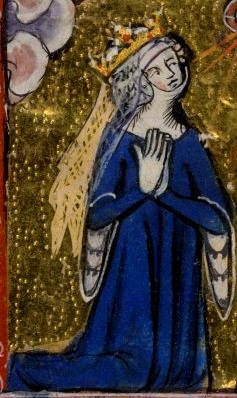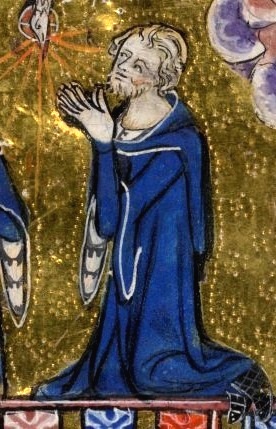by Susan Flantzer
© Unofficial Royalty 2022

Eleanor of Woodstock, Duchess of Guelders; Credit – Wikipedia
Eleanor of Woodstock, the second wife of Reinald II, Duke of Guelders, was born on June 18, 1318, at Woodstock Palace in Woodstock, Oxfordshire, England. Eleanor was named after her paternal grandmother Eleanor of Castile, Queen of England. During the reign of the House of Plantagenet, their children were often identified by their place of birth, and so Eleanor was called “of Woodstock”. She was the third of the four children and the elder of the two daughters of King Edward II of England and Isabella of France. Eleanor’s paternal grandparents were King Edward I of England and his first wife Eleanor of Castile. Her maternal grandparents were King Philippe IV of France and Joan I, Queen of Navarre in her own right.
Eleanor had three siblings:
- King Edward III of England (1312 – 1377), married Philippa of Hainault, had fourteen children
- John of Eltham, 1st Earl of Cornwall (1316 – 1336), unmarried
- Joan of The Tower (1321 – 1362), married King David II of Scotland, no children
Eleanor and her siblings had a difficult childhood. Their father Edward II was a weak king and his relationship with his favorites Piers Gaveston and Hugh Despenser the Younger, whether they were friends, lovers, or sworn brothers, was problematic and caused discontent both among the nobles and the royal family. Opposition to the regime grew, and when Edward II’s wife Isabella was sent to France to negotiate a peace treaty in 1325, she turned against Edward II and refused to return. Isabella allied herself with the exiled Roger Mortimer, 3rd Baron Mortimer, 1st Earl of March, and invaded England with a small army in 1326. Edward II’s regime collapsed and he fled to Wales, where he was captured in November 1326. Edward II was forced to give up his crown in January 1327 in favor of his son 14-year-old son King Edward III, with Isabella and Mortimer acting as regents. King Edward II died in Berkeley Castle on September 21, 1327, probably murdered on the orders of Isabella and Mortimer.
In 1324, because of a war with France, Hugh le Despenser, the favorite of Eleanor’s father King Edward II, took custody of six-year-old Eleanor and her sister three-year-old Joan from their mother Queen Isabella, claiming that Isabella, who had been born in France, could possibly incite her children to betray their father. Eleanor and Joan were placed in the care of Hugh le Despenser’s sister Isabel le Despenser and her husband Ralph de Monthermer, 1st Baron Monthermer. For the next two years, Eleanor lived at Pleshey Castle and Marlborough Castle, de Monthermer’s estates. When King Edward II was deposed in 1326, Eleanor and Joan were returned to the custody of their mother.
In 1328, things changed for Eleanor, her brother King Edward III, and her sister Joan. In January 1328, Edward III married Philippa of Hainault. Soon after, Eleanor was moved to the household of her new sister-in-law who became her guardian. England and Scotland signed the Treaty of Edinburgh-Northampton in the spring of 1328, formally ending the First War of Scottish Independence. One of the terms of the treaty was that seven-year-old Joan of England would marry four-year-old David, the son and heir of Robert I the Bruce, King of Scots. Eleanor and her mother accompanied Joan to Berwick-upon-Tweed, the northernmost town in England, 2 ½ miles from the border with Scotland, where the young couple was married in July 1328. Less than a year after the wedding, Robert the Bruce died, and Joan’s five-year-old husband became King David II of Scots and eight-year-old Joan became Queen of Scots.
There had been some negotiations for a marriage for Eleanor. In 1325, there were negotiations between England and Castile for Eleanor to be betrothed to King Alfonso XI of Castile, but the betrothal never occurred due to disagreements over the dowry. The future King Jean II of France was a prospective groom for Eleanor in 1329 and in 1330, there were negotiations for Eleanor to marry the future King Pedro IV of Aragon. Neither negotiation resulted in a marriage. Since marriages to a king or future king had failed, Eleanor had to settle for a count who was twenty-three years older than her.

Reinald II, Count of Guelders, later Duke of Guelders; Credit – Wikipedia
Eleanor’s brother King Edward III had negotiated an alliance with Reinald II, then Count of Guelders and later Duke of Guelders, in connection with the English-French conflicts, but marriage to his sister had not been one of the goals. Exactly how the marriage came about is not known. Eleanor did not have a dowry and so the initiative for the marriage may have come from Reinald. It is also possible that Willem II, Count of Hainault and/or his wife Joan of Valois, the parents of Edward III’s wife Philippa, played a role in arranging the marriage. Willem was interested in an English-Guelders alliance and Joan had a reputation as a talented mediator.
There appears to have been a proxy marriage on October 20, 1331, in England. In May 1332, 14-year-old Eleanor and 37-year-old Reinald II, Count of Guelders were married in person in Nijmegen, County of Guelders, now in the Netherlands. The County of Guelders, later the Duchy of Guelders, was located in parts of present-day the Netherlands and the present-day German state of North Rhine-Westphalia. In 1339, during Reinald II’s reign, the County of Guelders was elevated to a Duchy.
Reinald had previously been married to Sophia Berthout, Lady of Mechelen who died in 1329. Reinald had four daughters from this marriage who were not much younger than their stepmother Eleanor. After Eleanor and Reinald’s two sons had no children, two of the four daughters became Duchess of Guelders in their own right.
Eleanor’s step-children, the children of Reinald and his first wife:
- Marguerite of Guelders, Lady of Mechelen (1320 – 1344)
- Mathilde of Guelders, Lady of Mechelen, Duchess of Guelders (1325 – 1384), married (1) Godfried van Loon-Heinsberg, no children (2) John, Count of Cleves, no children (3) John II, Count of Blois, no children
- Elisabeth of Guelders (circa 1327 – 1376), Abbess of Gravendaal, unmarried
- Marie of Guelders, Duchess of Guelders (circa 1328 – 1405), married Wilhelm II, Duke of Jülich, had two sons and one daughter, both sons succeeded as Duke of Guelders and Duke of Jülich
Eleanor and Reinald had two sons.
- Reinald III, Duke of Guelders (1333 – 1371), married Marie of Brabant, no children
- Edward, Duke of Guelders (1336 – 1371), unmarried
Eleanor and Reinald had problems in their marriage, and Reinald began to depend more upon Jan Moliart, his chaplain and chief adviser. Moliart was accused of isolating Reinald from Eleanor and spreading rumors that Eleanor was suffering from leprosy. Because of the leprosy rumors, Eleanor was banished from court. She lived in Rosendael Castle, near Arnhem, County of Guelders, now in the Netherlands, probably with her youngest son. When Reinald attempted to annul the marriage, an angry Eleanor walked from Rosendael Castle to the Valkhof, a royal palace in Nijmegen, to contest the annulment. In front of the court, Eleanor threw off her cloak and bared her arms to prove she did not have leprosy, forcing Reinald to take her back.
On October 12, 1343, 48-year-old Reinald II, Duke of Guelders died after a riding accident. The Council of State elected two guardians and regents for nine-year-old son Reinald III, Duke of Guelders, his mother Eleanor and Dirk van Valkenburg, and Dirk’s brother Jan van Valkenburg was elected stadtholder. The van Valkenburgs made the situation so difficult for Eleanor that she was forced to resign her post of regent, and in 1344, her son Reinald III, Duke of Guelders was formally declared to have reached his majority, and therefore, there was no need of a regency.

Broederenkerk, where Eleanor is buried; Credit – By Dguendel – Own work, CC BY 4.0, https://commons.wikimedia.org/w/index.php?curid=68105428
In 1350, with encouragement from his mother, Eleanor’s younger son Edward began a civil war against his brother Reinald III for control of the Duchy of Guelders. When Eleanor attempted to reconcile with her son Reinald, he rejected her reconciliation attempts and confiscated her property. Eleanor was then forced to retire to the Cistercian convent in Deventer, a city that was part of the Hanseatic League, now in the Netherlands. Eleanor did not want to ask her brother King Edward III of England for help. She died in poverty at the convent on April 22, 1355, aged 36. Eleanor was buried at the Broederenkerk (link in Dutch), officially the Roman Catholic St. Lebuinus Church in Deventer that had been built on the order of Eleanor.

Eleanor was buried somewhere in front of the high altar of Broederenkerk; Credit – www.findagrave.com
Eleanor did not live long enough to see the results of the civil war between her two sons. In 1361 Edward gained power and became Duke of Guelders, and Reinald III was captured and imprisoned. Edward reigned until August 24, 1371, when he was killed in a battle caused by a disagreement between his brother-in-law Wilhelm II, Duke of Jülich and Wenceslaus I, Duke of Luxembourg. Upon Edward’s death, his brother Reinald III regained the Duchy of Guelders but he died shortly afterward, on December 4, 1371. As neither Edward nor Reinald had children, another war of succession for Guelders began.
This article is the intellectual property of Unofficial Royalty and is NOT TO BE COPIED, EDITED, OR POSTED IN ANY FORM ON ANOTHER WEBSITE under any circumstances. It is permissible to use a link that directs to Unofficial Royalty.
Works Cited
- Aliénor d’Angleterre (1318-1355) (2022) Wikipedia (French). Wikimedia Foundation. Available at: https://fr.wikipedia.org/wiki/Ali%C3%A9nor_d%27Angleterre_(1318-1355) (Accessed: November 23, 2022).
- Eleanor of Woodstock (2022) Wikipedia. Wikimedia Foundation. Available at: https://en.wikipedia.org/wiki/Eleanor_of_Woodstock (Accessed: November 23, 2022).
- Flantzer, Susan. (2016) King Edward II of England, Unofficial Royalty. Available at: https://www.unofficialroyalty.com/king-edward-ii-of-england/ (Accessed: November 23, 2022).
- Foley, Liam. (no date) Reginald II of Guelders, European Royal History. Available at: https://europeanroyalhistory.wordpress.com/tag/reginald-ii-of-guelders/ (Accessed: November 23, 2022).
- Tuchman, Barbara. (1978) A Distant Mirror. The Calamitous 14th Century. New York: Random House
- Weir, Alison. (1989) Britain’s Royal Families: The Complete Genealogy. London: Vintage Books.
- Williamson, David. (1996) Brewer’s British royalty: A Phrase and Fable dictionary. London: Cassell.
